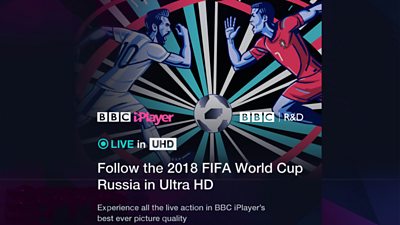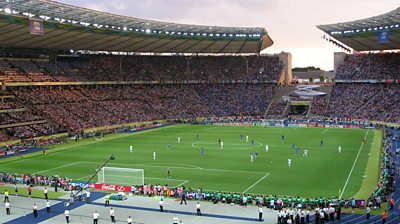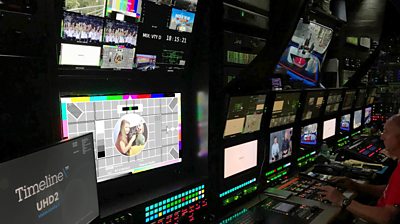I’d like to follow-up on the of the in iPlayer with some further details. Colleagues across R&D, ±«Óãtv Design+Engineering, Sport and Distribution & Business Development have been working together since early 2018 to develop and prove the production, contribution and distribution workflows necessary to support such an event.

We have run a series of trial events to allow consumer equipment manufacturers to develop the capabilities in their products to support iPlayer. , and were very happy we could use some of the FA Cup Final to prove our final distribution chain. So, we are very pleased we are at the point where we can run a major event using the infrastructure we have assembled.
As , our interest is very much about how we use the open Internet to create new services for our audience. This trial is another step on that journey as it will let us assess the capabilities of the UK Internet infrastructure.
Each event we have covered has presented different challenges, e.g. my colleague Andrew Cotton recently explained how we developed a Hybrid Log-Gamma High Dynamic Range live workflow for the Royal Wedding which enabled us to capture the event for posterity in UHD HLG. For our World Cup coverage, we will be using the ' UHD HDR feed and adding in our own studio presentation up-converted from HD.
The distribution to iPlayer will be Main 10 Profile, Level 5.1 HEVC with HLG signalling. This is the same as we used for our Blue Planet II trials. For Blue Planet II we were able to use non real-time encoding. For our World Cup 2018 coverage we must use real-time encoding. The current state of the art for live HEVC encoding means we need to use increased bitrates and reduce the number of representations we can make available. For the World Cup we will be offering:
3840x2160p50 36Mbit/s
2560x1440p50 16Mbit/s
1920x1080p50 10Mbit/s
1280x720p50 7Mbit/s

The audio will be stereo AAC-LC at 192 kbit/s. Whilst we would like to provide multi-channel sound we have found a number of issues with receivers which are difficult to work-around. We will continue to explore solutions for future events.
- ±«Óãtv iPlayer - Can I watch the World Cup live in Ultra HD on my connected TV?
- ±«Óãtv R&D - How to Adjust Your TV to Enjoy the Best Picture Quality in HDR
- ±«Óãtv R&D - Royal Wedding in High Dynamic Range
The high video bitrates have been chosen to maintain picture quality, but this does mean that some viewers who could watch Blue Planet II may not be able to receive the World Cup streams, as a minimum capacity of 40Mbit/s will be needed to get the full 3840 pixel resolution representation. A 20Mbit/s connection should be capable of providing the 2560 pixel resolution representation. As HEVC encoding develops we very much hope the real-time encoders will be capable of matching and eventually bettering the bitrates we use for on-demand, but this will require a big increase in computational power.
The packaging will be DVB-DASH, again using R&D developed software with final distribution via content delivery networks. The adoption of open international standards means that iPlayer gains the capability to decode UHD HLG using the capabilities of the receiver it is running on.

The production workflow for the World Cup is not native HLG as Host Broadcaster Services have defined their own HDR workflow. We will be converting this to HLG for iPlayer and standard dynamic range BT.2020 UHD receivers will be able to exploit the backwards compatibility of HLG. For future events we hope the ground-breaking work at the Royal Wedding will lead to simpler, native HLG workflows which allow HD, UHD and UHD HLG versions of the event to be produced from the same camera feeds and without the complexity of metadata to manage through the broadcast chain.
We hope this trial provides us with further insights into the capabilities of the UK Internet for handling high capacity services. To further Matthew’s vision we are working on a number of technologies to improve how such services could be carried in the future at significant scale. It will be interesting to see how the World Cup trial helps in the development of a universal open UK Internet that supports such events.
- - Share on Facebook
- ±«Óãtv Sport - World Cup 2018: ±«Óãtv to show tournament in Ultra HD & virtual reality
- ±«Óãtv News - World Cup 2018: ±«Óãtv iPlayer to stream matches in 4K HDR
- ±«Óãtv R&D - Getting UHD Back from Brazil - ±«Óãtv R&D's 2014 World Cup Trials
- from the ±«Óãtv Academy including:
-

Broadcast and Connected Systems section
Broadcast & Connected Systems primarily focuses on how ±«Óãtv content reaches our viewers through broadcast and Internet delivery. This involves the whole broadcast chain from playout, through coding and distribution to consumption on the end-user's device. Our work typically covers a period from now through to 3 years out from deployment.
